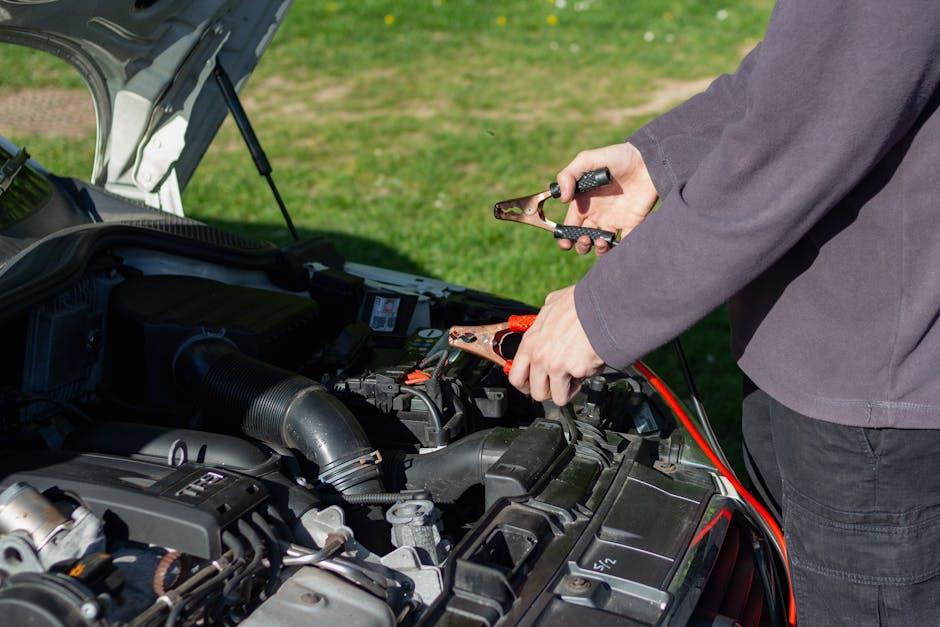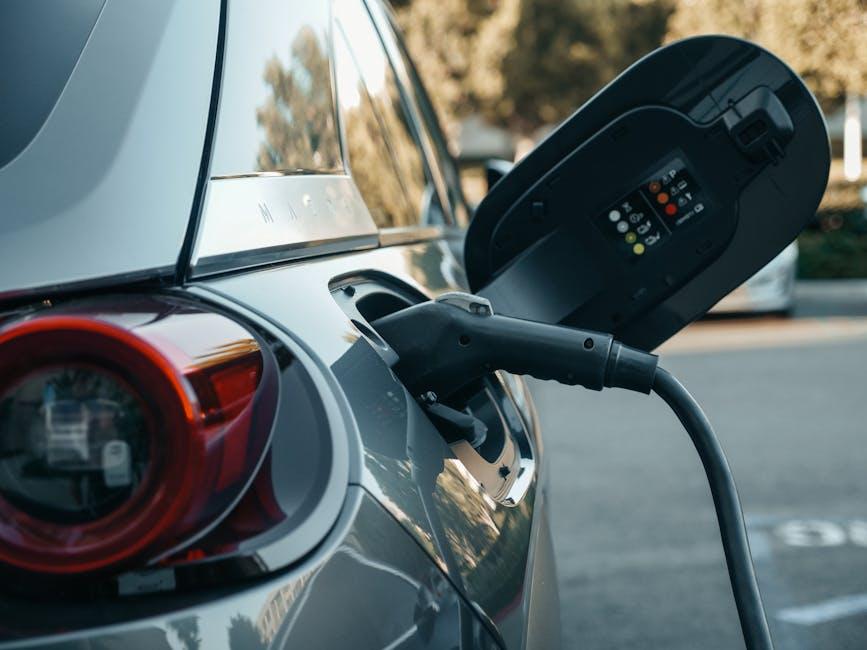Beneath the hood of every car lies a silent powerhouse: the battery. This compact device kick-starts your engine, powers your electronics, and keeps your journey moving smoothly. Yet, despite its vital role, car batteries are often overlooked when it comes to safety. Handling them improperly can lead to unexpected malfunctions or even hazards. In this article, we delve into essential car battery safety tips—guiding you to protect both your vehicle and yourself, ensuring every drive begins and ends on a safe note.
Table of Contents
- Understanding the Basics of Car Battery Safety
- Identifying Signs of a Faulty or Damaged Battery
- Proper Handling and Installation Techniques
- Essential Protective Gear and Precautions
- Regular Maintenance Practices to Extend Battery Life
- Emergency Steps for Battery-Related Hazards
- Q&A
- In Conclusion

Understanding the Basics of Car Battery Safety
Car batteries might seem straightforward, but they harbor a lot of power beneath their compact exterior. Knowing how to properly handle and maintain them is essential to preventing accidents and ensuring your vehicle starts reliably every time. Always wear protective gloves and safety goggles when working around a battery since the sulfuric acid inside is highly corrosive and can cause severe burns. Avoid smoking or producing sparks near the battery, as the hydrogen gas it emits is highly flammable and can lead to explosions.
- Check terminal connections regularly to prevent corrosion buildup, which can impede electrical flow.
- Never touch both terminals simultaneously with metal tools or jewelry to avoid short circuits.
- Keep batteries upright to prevent acid leakage, especially if transporting or storing outside the vehicle.
Understanding these safety fundamentals helps not only in protecting yourself but also in extending the life of your battery. When charging, always use a charger compatible with your battery type, and ensure proper ventilation in the area to dissipate any hazardous gases. Regular visual inspections can alert you to swelling, cracks, or leaks early on. Remember, a cautious approach keeps you safe and your vehicle running smoothly.

Identifying Signs of a Faulty or Damaged Battery
Spotting early warning signs is crucial for preventing unexpected battery failures. Look out for a sluggish engine start, dim headlights, or flickering dashboard lights, which often signal a weakening battery. Corrosion buildup around battery terminals, visible cracks, or a swollen battery casing are physical indicators that shouldn’t be ignored. Additionally, a persistent sulfuric smell near your battery might indicate internal damage, suggesting it’s time for an inspection or replacement.
To help you quickly assess battery issues, here’s a simple guide that highlights common symptoms alongside their potential causes:
| Symptom | Possible Cause |
|---|---|
| Slow engine crank | Low battery charge or aging cells |
| Corroded terminals | Acid leak or exposure to moisture |
| Dashboard warning lights | Electrical faults or charge problems |
| Swollen battery case | Overcharging or heat damage |
| Foul odor near battery | Internal leakage or acid spill |

Proper Handling and Installation Techniques
When working with car batteries, taking your time during installation can prevent costly mistakes and enhance safety. Always start by wearing protective gloves and goggles to shield yourself from acid spills or sparks. Before handling the battery, ensure the vehicle’s ignition is off and remove any metal jewelry that could cause accidental shorts. Remember to connect the cables in the correct order: attach the positive (+) terminal first, followed by the negative (-) terminal. This sequence minimizes the risk of sparks. Additionally, avoid forcing terminals or cable connectors; if they don’t fit easily, inspect for corrosion or dirt and clean them with a baking soda solution or a designated battery cleaner.
Proper placement and securing of the battery are just as crucial as connection. Use the designated holder or bracket inside the battery compartment to keep the battery firmly in place to prevent vibrations which might damage internal components. Below is a quick reference table summarizing key installation do’s and don’ts:
| Do | Don’t |
|---|---|
| Use insulated tools | Use metal tools without covers |
| Check terminals for corrosion | Ignore green or white powder build-up |
| Secure battery tightly | Leave battery loose in the tray |
| Handle battery upright | Lay battery on its side |
Following these careful handling and installation steps not only prolongs battery life but also keeps you safe from electrical hazards and chemical exposure. Taking precautions will ensure your vehicle starts reliably and your battery performs at its best.

Essential Protective Gear and Precautions
Before handling a car battery, it is crucial to equip yourself with the correct protective gear to minimize risks. Always wear chemical-resistant gloves to protect your skin from the corrosive battery acid. Safety goggles are a must to shield your eyes from potential acid splashes or debris. Additionally, closed-toe shoes or boots provide essential protection for your feet, preventing injury from dropped tools or battery components. For extra safety, consider wearing a long-sleeved shirt to limit skin exposure.
Alongside personal protection, several simple precautions can prevent accidents and extend the life of your battery. When working near the battery, never smoke or create sparks, as batteries emit flammable gases. Always disconnect the negative terminal first to avoid short circuits, and keep metal tools away from both terminals simultaneously. To help you remember key practices, here is a quick reference:
| Precaution | Description |
|---|---|
| Disconnect order | Negative terminal first, reconnect last |
| Ventilation | Work in a well-ventilated area |
| No open flames | Avoid sparks or smoking nearby |
| Tool safety | Use insulated tools |
- Keep a baking soda solution nearby to neutralize any acid spills immediately.
- Avoid leaning directly over the battery while working to reduce exposure to gases or acid.
- Regularly inspect battery terminals for corrosion and clean them promptly.

Regular Maintenance Practices to Extend Battery Life
Consistent upkeep is the cornerstone of preserving your car battery’s lifespan. Make it a habit to inspect the battery terminals for corrosion which can impede electrical flow and cause starting problems. Use a mixture of baking soda and water to clean off any buildup, ensuring a solid connection. Additionally, check the battery’s fluid levels if your model allows it; topping up with distilled water can prevent damage from overheating and sulfation. Don’t forget to keep the battery securely fastened to minimize vibrations, which can accelerate wear and tear.
Regular charging practices also play a crucial role in battery longevity. Avoid leaving your battery drained for extended periods by driving your vehicle frequently or using a quality trickle charger when the car is idle for weeks. Below is a simple maintenance schedule to guide your routine care:
| Maintenance Task | Frequency | Key Benefit |
|---|---|---|
| Terminal Cleaning | Every 3 months | Prevents corrosion buildup |
| Fluid Level Check | Monthly (if applicable) | Prevents overheating & sulfation |
| Battery Charge Check | Bi-monthly | Avoids deep discharge damage |
| Secure Battery | With every service | Reduces vibration stress |

Emergency Steps for Battery-Related Hazards
In the event of a battery-related emergency, quick and calm action can prevent serious injury and damage. First, if you notice smoke, sparks, or a strong sulfur odor, immediately disconnect the battery, but only if it is safe to do so. Move away from the vehicle and alert others to keep a safe distance. Avoid any open flames or smoking near the battery, as it may release explosive hydrogen gas. If the battery leaks acid, use appropriate personal protective equipment like gloves and goggles before attempting to neutralize the spill with a baking soda and water mixture.
Should you experience skin or eye contact with battery acid, rinse the affected area with plenty of clean water for at least 15 minutes and seek medical attention promptly. In case of fire, use a Class C or multipurpose dry chemical fire extinguisher. Avoid using water, which can worsen battery fires. Below is a quick reference table for handling common battery emergencies:
| Emergency | Immediate Action | Safety Tip |
|---|---|---|
| Smoke or Sparks | Disconnect battery carefully, evacuate area | Avoid flames; alert others |
| Acid Leak | Neutralize with baking soda solution | Wear gloves and eye protection |
| Fire | Use Class C fire extinguisher | Do not use water |
| Chemical Contact | Rinse area with water | Seek medical help |
Q&A
Q&A: Car Battery Safety Tips
Q1: Why is it important to handle car batteries with care?
A1: Car batteries contain corrosive acid and store significant electrical energy, which can cause burns, electrical shocks, or explosions if mishandled. Proper care ensures your safety and prolongs the battery’s lifespan.
Q2: What personal protective equipment (PPE) should I use when working with a car battery?
A2: Always wear safety goggles to shield your eyes from acid splashes, gloves to protect your hands from corrosive materials, and avoid loose clothing or jewelry that could accidentally create a short circuit.
Q3: How can I safely check the battery without risking electric shock?
A3: Use insulated tools designed for automotive work and never touch both battery terminals at the same time. Ensure the car ignition is off before inspecting or handling the battery.
Q4: What steps should I follow when jump-starting a car battery?
A4: Connect the positive cables first, then the negatives; ensure clamps don’t touch each other; keep sparks and flames away; and always follow the vehicle manufacturer’s instructions. Disconnect cables in reverse order once the car starts.
Q5: Are there environmental hazards related to car batteries?
A5: Yes, car batteries contain toxic lead and acid that can harm the environment. Always recycle old batteries at authorized collection points and never dispose of them in regular trash.
Q6: What signs indicate that a battery might be unsafe or failing?
A6: Look out for corrosion around terminals, swelling or leaks in the battery casing, a rotten egg smell (indicating leaking acid), or difficulty starting your car. If you notice these, have the battery checked or replaced promptly.
Q7: How should I store a spare car battery?
A7: Keep it in a cool, dry place away from direct sunlight or heat sources. Place it on a non-conductive surface and avoid storing it near metal objects that could cause a short circuit.
Q8: Can car batteries explode? How can I prevent that?
A8: Yes, hydrogen gas emitted during charging can ignite explosively if sparks occur. Prevent explosions by avoiding open flames, smoking, or creating sparks near the battery and ensuring wiring is in good condition.
Q9: What maintenance tips keep a battery safe and functional?
A9: Regularly clean battery terminals, check electrolyte levels if applicable, securely fasten the battery in place, and inspect cables for damage or corrosion.
Q10: What should I do immediately if battery acid contacts my skin or eyes?
A10: Rinse the affected area with plenty of water for at least 15 minutes and seek medical attention immediately. Quick response minimizes damage from acid burns.
By understanding and applying these safety tips, you can handle your car battery confidently and prevent accidents before they happen.
In Conclusion
In the end, a car battery is more than just a power source—it’s the silent partner that keeps you moving. Treat it with respect and caution, and it will reward you with reliable starts and smooth journeys. By embracing these safety tips, you not only protect yourself and your vehicle but also extend the life of this vital component. So next time you pop the hood, remember: a little care goes a long way in keeping your battery—and your adventures—fully charged.

